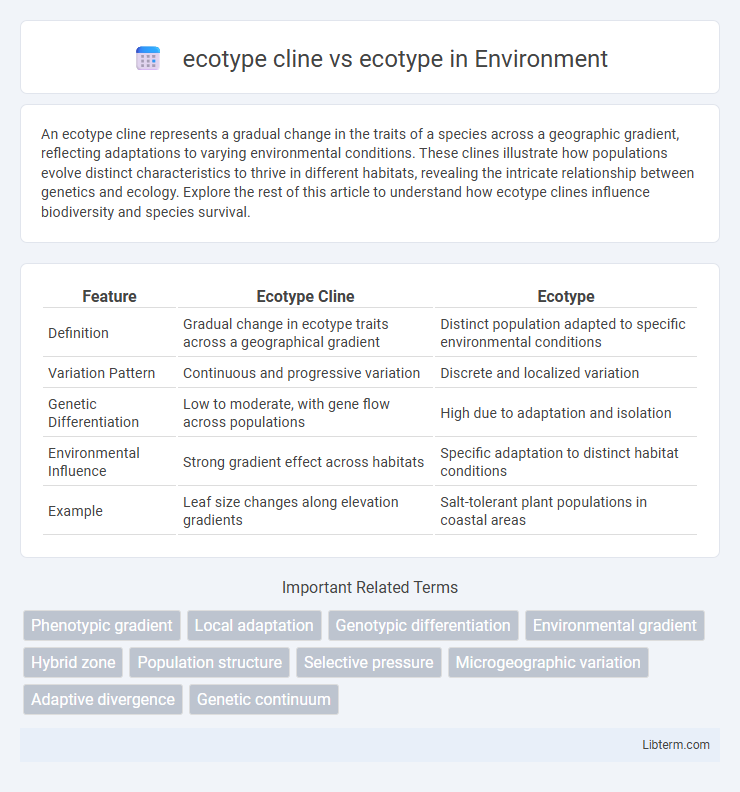An ecotype cline represents a gradual change in the traits of a species across a geographic gradient, reflecting adaptations to varying environmental conditions. These clines illustrate how populations evolve distinct characteristics to thrive in different habitats, revealing the intricate relationship between genetics and ecology. Explore the rest of this article to understand how ecotype clines influence biodiversity and species survival.
Table of Comparison
| Feature | Ecotype Cline | Ecotype |
|---|---|---|
| Definition | Gradual change in ecotype traits across a geographical gradient | Distinct population adapted to specific environmental conditions |
| Variation Pattern | Continuous and progressive variation | Discrete and localized variation |
| Genetic Differentiation | Low to moderate, with gene flow across populations | High due to adaptation and isolation |
| Environmental Influence | Strong gradient effect across habitats | Specific adaptation to distinct habitat conditions |
| Example | Leaf size changes along elevation gradients | Salt-tolerant plant populations in coastal areas |
Defining Ecotype: A Basic Overview
An ecotype represents a genetically distinct population within a species, adapted to specific environmental conditions. Ecotype clines illustrate gradual phenotypic or genetic changes across a geographic gradient, reflecting continuous adaptation. Understanding ecotypes involves examining traits influenced by local factors such as climate, soil, and altitude, which drive evolutionary divergence within species.
Understanding Ecotype Clines
Ecotype clines represent gradual genetic and phenotypic variations in populations of a species along environmental gradients, contrasting with distinct ecotypes that show more discrete adaptations to specific habitats. Understanding ecotype clines involves examining how selective pressures such as temperature, altitude, or moisture influence continuous trait changes across geographic ranges. This knowledge aids in predicting species' responses to environmental shifts and enhances conservation strategies by highlighting adaptive potential within species.
Key Differentiators: Ecotype vs Ecotype Cline
Ecotype refers to a genetically distinct population within a species adapted to specific environmental conditions, while an ecotype cline represents a gradual, continuous variation in traits across a geographical gradient. Key differentiators include genetic distinctness, with ecotypes showing discrete boundaries, and ecotype clines exhibiting smooth transitions without sharp demarcations. Ecotype clines highlight adaptive variation influenced by environmental gradients, contrasting with the localized adaptation characteristic of individual ecotypes.
Genetic Variation in Ecotypes and Clines
Genetic variation in ecotypes represents distinct populations within a species adapted to specific environmental conditions, while ecotype clines illustrate gradual genetic changes across geographic gradients reflecting continuous environmental variation. Ecotypes show discrete genetic differentiation, often correlated with particular habitat features, whereas clines capture smooth allelic frequency shifts influenced by factors like temperature, altitude, or latitude. Understanding genetic variation in ecotypes and clines informs evolutionary processes, adaptation mechanisms, and biodiversity conservation strategies.
Environmental Gradients and Clinal Adaptation
Ecotype clines describe gradual variations in phenotypic traits or genotypes of a species along environmental gradients such as temperature, altitude, or moisture, reflecting clinal adaptation to specific ecological conditions. In contrast, ecotypes represent distinct populations within a species adapted to particular habitats, exhibiting relatively discrete genetic and phenotypic differentiation. Environmental gradients drive selective pressures that shape clinal adaptation, promoting continuous genetic variation across populations rather than abrupt shifts typical of separate ecotypes.
Real-World Examples: Ecotype Case Studies
Ecotype clines illustrate gradual genetic and phenotypic changes along environmental gradients, as observed in the North American grass species Bouteloua gracilis, which adapts from moist to arid regions. In contrast, distinct ecotypes emerge sharply adapted to specific habitats, such as the marine and freshwater ecotypes of the three-spined stickleback (Gasterosteus aculeatus) exhibiting morphological differences aligned with salinity variations. Case studies like these deepen understanding of adaptive evolution by highlighting how gene flow and selective pressures shape ecotype differentiation within species.
Illustrative Cases of Ecotype Clines
Ecotype clines represent gradual changes in genetic or phenotypic traits within a species across geographical gradients, contrasting with distinct ecotypes that exhibit sharp boundaries. Illustrative cases include the variation in plant height and leaf size of lodgepole pine (Pinus contorta) along altitudinal gradients, reflecting adaptation to temperature and moisture. Similarly, Drosophila melanogaster displays clinal variation in body size and heat tolerance across latitudes, demonstrating continuous environmental selection pressures rather than discrete ecotype differentiation.
Evolutionary Significance in Population Structure
Ecotype clines represent gradual genetic and phenotypic changes along environmental gradients, reflecting adaptive responses that enhance survival and reproduction in varying habitats. In contrast, distinct ecotypes are discrete populations with specialized traits adapted to specific environmental conditions, indicating localized selection pressures. The evolutionary significance lies in ecotype clines facilitating gene flow and continuous adaptation, while distinct ecotypes promote population divergence and potential speciation within broader population structures.
Implications for Conservation and Biodiversity
Ecotype clines represent gradual variations within species across environmental gradients, while ecotypes are distinct, localized populations adapted to specific habitats. Recognizing ecotype clines helps conservationists maintain genetic diversity and adaptive potential by preserving continuous habitats that support these evolutionary gradients. Protecting both ecotypes and their clinal variation enhances biodiversity resilience against climate change and habitat fragmentation.
Future Research Directions in Ecotype Clines and Ecotypes
Future research in ecotype clines and ecotypes is essential for understanding adaptive variation across environmental gradients and its genetic underpinnings. Advances in genomics and spatial modeling will enable precise identification of clinal patterns and dissect the role of gene flow and selection in ecotype differentiation. Integrating long-term ecological data with molecular techniques promises to enhance predictions of species' responses to climate change, supporting conservation and management strategies.
ecotype cline Infographic

 libterm.com
libterm.com